CPWC (low-resolution) simulation with the USTB built-in Fresnel simulator
In this example we show how to use the built-in fresnel simulator in USTB to generate a Coherent Plane-Wave Compounding (CPWC) dataset and how it can be beamformed with USTB.
Related materials:
This tutorial assumes familiarity with the contents of the 'CPWC simulation with the USTB built-in Fresnel simulator' tutorial. Please feel free to refer back to that for more details.
by Alfonso Rodriguez-Molares alfonso.r.molares@ntnu.no and Arun Asokan Nair anair8@jhu.edu 16.05.2017
Contents
Phantom
Our first step is to define an appropriate phantom structure as input. Our phantom here is simply a single point scatterer. USTB's implementation of phantom comes with a plot method for free!
pha=uff.phantom(); pha.sound_speed=1540; % speed of sound [m/s] pha.points=[0, 0, 40e-3, 1]; % point scatterer position [m] fig_handle=pha.plot();
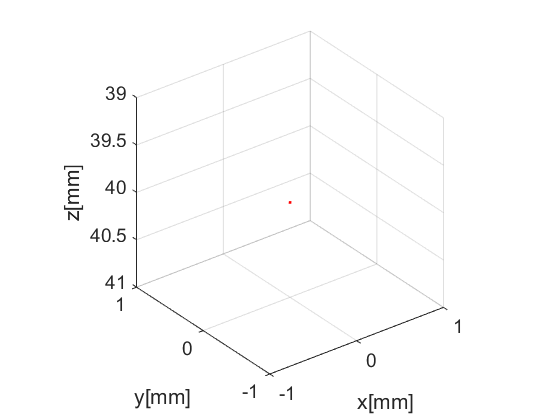
Probe
Another UFF structure is probe. You've guessed it, it contains information about the probe's geometry. USTB's implementation comes with a plot method. When combined with the previous Figure we can see the position of the probe respect to the phantom.
prb=uff.linear_array(); prb.N=128; % number of elements prb.pitch=300e-6; % probe pitch in azimuth [m] prb.element_width=270e-6; % element width [m] prb.element_height=5000e-6; % element height [m] prb.plot(fig_handle);
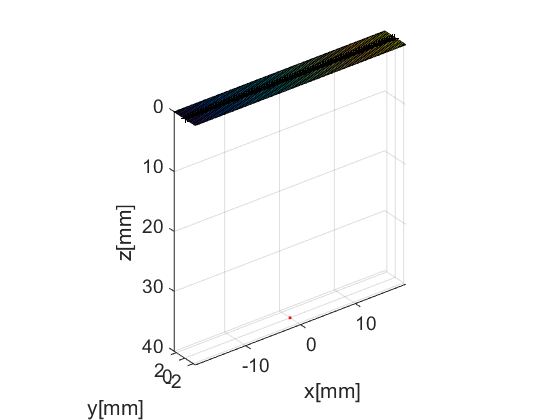
Pulse
We then define the pulse-echo signal which is done here using the fresnel simulator's pulse structure. We could also use 'Field II' for a more accurate model.
pul=uff.pulse(); pul.center_frequency=5.2e6; % transducer frequency [MHz] pul.fractional_bandwidth=0.6; % fractional bandwidth [unitless] pul.plot([],'2-way pulse');
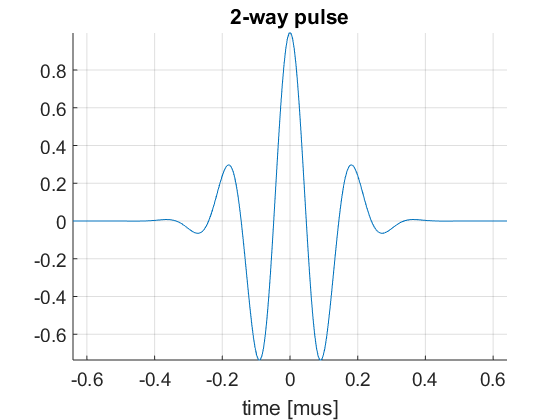
Sequence generation
Now, we shall generate our sequence! Keep in mind that the fresnel simulator takes the same sequence definition as the USTB beamformer. In UFF and USTB a sequence is defined as a collection of wave structures.
For our example here, we define a sequence of 3 plane-waves covering an angle span of ![$[-0.3, 0.3]$](CPWC_linear_array_low_quality_PW_images_eq14339125197225071258.png) radians. The wave structure has a plot method which plots the direction of the transmitted plane-wave.
radians. The wave structure has a plot method which plots the direction of the transmitted plane-wave.
N=3; % number of plane waves angles=linspace(-0.3,0.3,N); % angle vector [rad] seq=uff.wave(); for n=1:N seq(n)=uff.wave(); seq(n).source.azimuth=angles(n); seq(n).source.distance=Inf; seq(n).probe=prb; seq(n).sound_speed=pha.sound_speed; % show source fig_handle=seq(n).source.plot(fig_handle); end
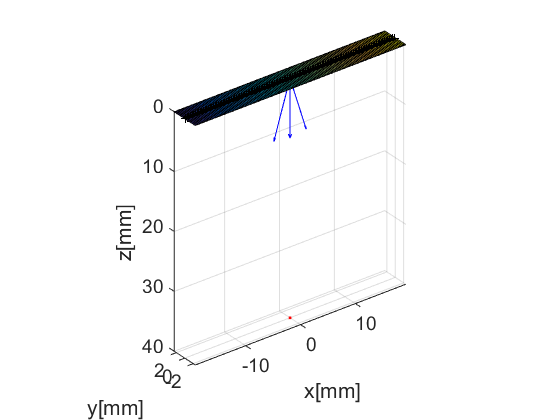
The Fresnel simulator
Finally, we launch the built-in simulator. The simulator takes in a phantom, pulse, probe and a sequence of wave structures along with the desired sampling frequency, and returns a channel_data UFF structure.
sim=fresnel(); % setting input data sim.phantom=pha; % phantom sim.pulse=pul; % transmitted pulse sim.probe=prb; % probe sim.sequence=seq; % beam sequence sim.sampling_frequency=41.6e6; % sampling frequency [Hz] % we launch the simulation. Go! channel_data=sim.go();
USTB's Fresnel impulse response simulator (v1.0.5) ---------------------------------------------------------------
Scan
The scan area is defines as a collection of pixels spanning our region of interest. For our example here, we use the linear_scan structure, which is defined with just two axes. scan too has a useful plot method it can call.
sca=uff.linear_scan(linspace(-3e-3,3e-3,200).', linspace(39e-3,43e-3,200).'); sca.plot(fig_handle,'Scenario'); % show mesh
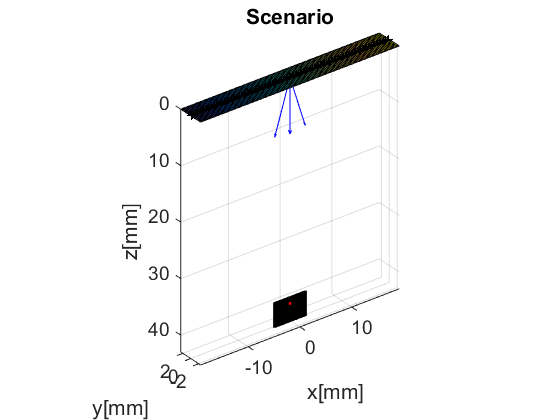
Beamformer
With channel_data and a scan we have all we need to produce an ultrasound image. We now use a USTB structure beamformer, that takes an apodization structure in addition to the channel_data and scan.
bmf=beamformer(); bmf.channel_data=channel_data; bmf.scan=sca; bmf.receive_apodization.window=uff.window.tukey50; bmf.receive_apodization.f_number=1.7; bmf.receive_apodization.apex.distance=Inf; % Setting transmit apodization to "none" since we want to look at the % individual low quality PW's bmf.transmit_apodization.window=uff.window.none;
The beamformer structure allows you to implement different beamformers by combination of multiple built-in processes. By changing the process chain other beamforming sequences can be implemented. It returns yet another UFF structure: beamformed_data.
% To achieve the goal of this example, we only use delay-and-sum ( % implemented in the *das_matlab()* process) and not coherent compounding % as we want to output the low quality PW images each formed from only one % plane wave transmission. b_data=bmf.go({process.das_matlab()});
Finally, display each individual low quality plane wave image. Fin!
figure('Position',[100 100 1000 300]) h1 = subplot(1,3,1); angle_1 = rad2deg(channel_data.sequence(1,1).source.azimuth); b_data(1,1).plot(h1,sprintf('PW at angle = %0.1f',angle_1)); h2 = subplot(1,3,2); angle_2 = rad2deg(channel_data.sequence(1,2).source.azimuth); b_data(1,2).plot(h2,sprintf('PW at angle = %0.1f',angle_2)); h3 = subplot(1,3,3); angle_3 = rad2deg(channel_data.sequence(1,3).source.azimuth); b_data(1,3).plot(h3,sprintf('PW at angle = %0.1f',angle_3));
